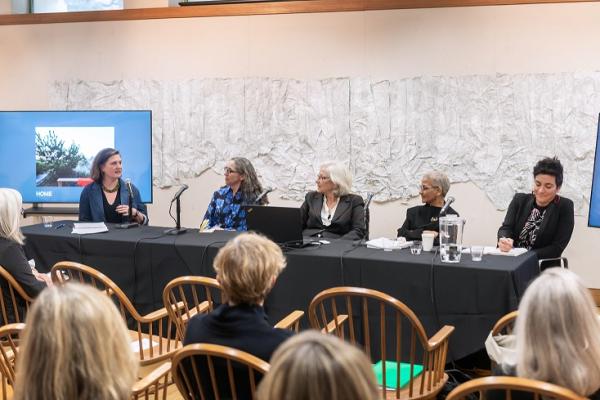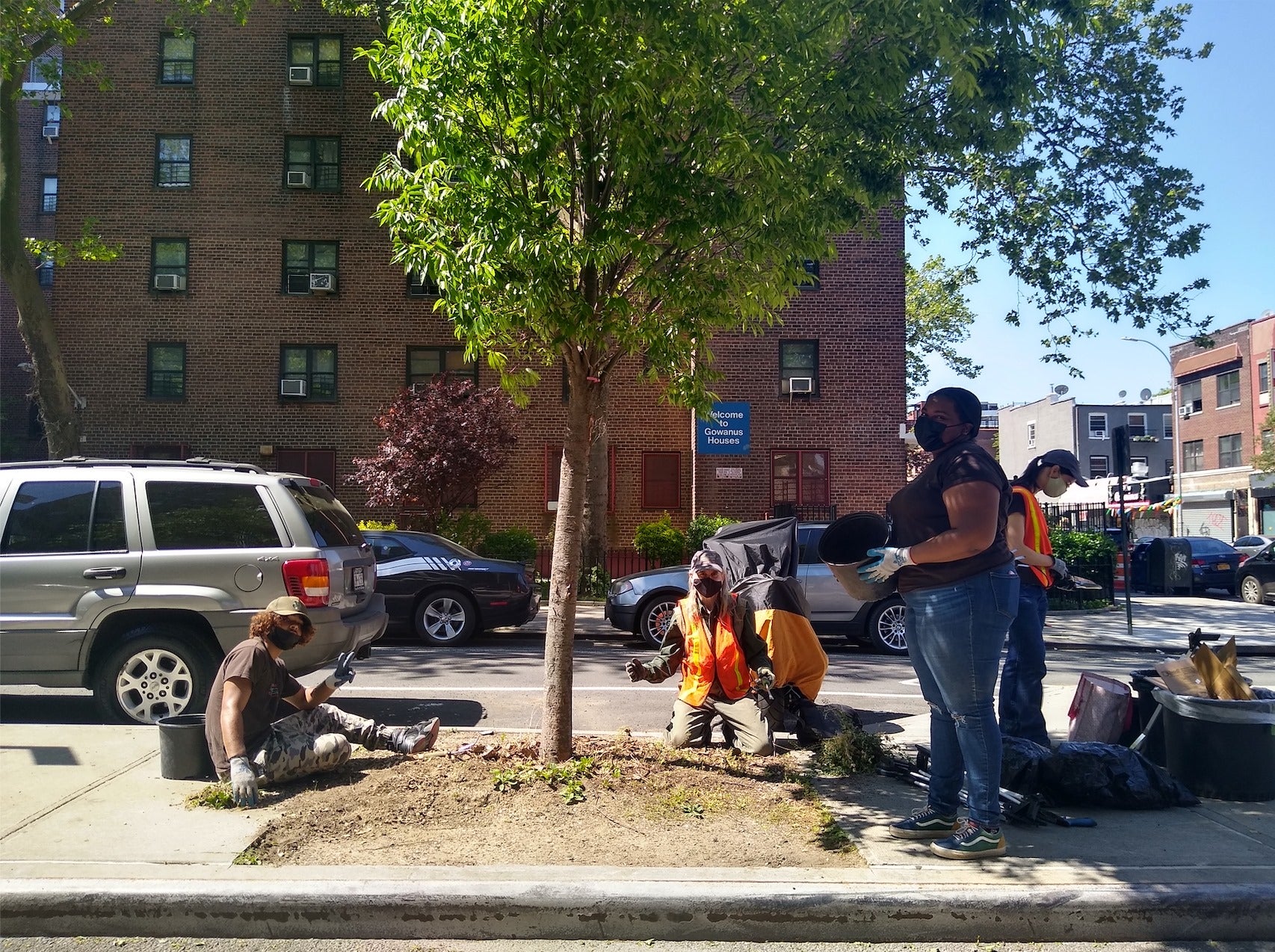In Support of Transgressive Practices: Cultivating New Landscape Imaginaries

Social movements are projects of reimagination and the organization of ongoing action. A landscape architect’s tools are well-suited for these tasks of shaping public imaginations and defining the first steps to build it. Ideas for change, like gardens, require tending by many hands to take root and flourish. Creating actionable visions of more environmentally sustainable ways of living requires the slow work of learning the nuances of a site and its constituents. Realizing these visions of change requires a capability to act beyond the limited moments of direct action within a project scope—for designers this is typically demolition, construction, occupancy.
While the timeline for imagining, promoting, building, and growing a landscape should be slow and meandering, a landscape architect’s work is often constrained by limited time and access to the places we design and the communities we serve. Our work may be further constrained by a site boundary, while the issues we aim to address—the impacts of climate change, biodiversity loss, and income inequality—register in our environment in patterns that do not obey land use boundaries or a specific agency’s jurisdiction.
Conventional landscape architecture projects are framed by these boundaries. The potential of our discipline to shape new imaginaries about how to engage these concerns lies in its complex contextual dependencies and its engagement with dynamic and constant change. Emerging conversations in design question the usefulness of obeying the conventions of landscape practice, recognizing that the way we have been building on and caring for land must change. And from these questions, alternative approaches to making landscapes are being modeled. These transgressive practices challenge disciplinary boundaries in order to catalyze policy change, informed by an understanding of the long-term environmental impacts on the ground.
As the 2021–2023 Meadows Foundation Centennial Fellow, I convened the symposium, Transgressive Practices to Transformative Policy: Landscape Change, Fast & Slow (fig. 1). The event brought together four designer-scholars whose work explores how landscape architects can shape social and ecological relationships. Responding to a call for landscape architects to embrace “transgressive practices,” the panelists proposed models of imagining, caring for, and making landscapes through practices with deep commitments to place. Documentation of the event’s presentations and discussion will be shared through a forthcoming volume of the Centerline series published by the school’s Center for American Architecture and Design.
Reflecting on the event, I have identified four ways that individual design projects can contribute to new public imaginations for how we build on and care for the land, while challenging the policies that often limit our work to replicating the status quo. These emerged from my own work in community-based practice. I volunteered with the Gowanus Canal Conservancy from 2011 to 2014, and have continued to study their work through interviews and site visits. And as a former director of the Small Center for Collaborative Design at Tulane School of Architecture, the outreach arm for the school, I had the honor of celebrating the official opening of Parisite Skatepark, after the Center helped with advocacy for the park and installed the park’s entry plaza and raingardens through a design-build course. These are just two projects that leverage ongoing design efforts to promote local engagement in shaping public space and caring for land. There are projects across the country that engage these processes. While some are led by designers and others by grassroots efforts, landscape architects can learn a lot from how incremental and ongoing practices to make and care for a place can serve as tools for organizing an engaged environmental public.
Sustained Commitment to Counter-Reality: Fast Prototypes and Ongoing Care

Holding up an ideal of a more just and ecologically sustainable world requires a commitment and hope for ideas that may not seem realistic in the immediate future. Working toward this counter-reality, as philosopher Judith Butler describes it in her writing on ethics in social movements, requires a willingness to be called naïve or dismissed as hopeful, and it requires the tenacity to continue to work toward an ideal. The Gowanus Canal Conservancy (GCC) began in 2006 as a nonprofit environmental advocacy group, initially engaged in conversations about the cleanup and remediation of the Gowanus Canal. Locally the organization’s identity as a “conservancy” references the city’s Central Park Conservancy, which led efforts to improve and enhance the park after a period of decline. This framing signals a deep commitment to an idea of the canal and its watershed as a diverse, living ecosystem worthy of the care given to the best public parks. For many New Yorkers, this image of the Gowanus is a counter-reality for a waterbody that is plagued by historic industrial pollution and ongoing combined sewer overflows. The GCC has helped to change these perceptions through a long-term commitment to improving the sustainability and biodiversity of the area through physical design interventions, ongoing stewardship, and other visible actions of care.
The GCC’s early work took the form of building small but visible prototypes of stormwater management infrastructure. Through community workdays, GCC staff would lead volunteers and interns through the process of installing and tending streetside bioswales and raingardens. Alongside these efforts, the Conservancy led trainings on street tree pruning, citizen science surveys of street trees and plant species, and walking tours of the neighborhood ecology and history (figs. 2, 3). In collaboration with the Gowanus Dredgers, they toured the canal on canoes. Their canoe rides actualized the idea of the Gowanus Canal as a recreational waterbody, thereby strengthening the argument to the EPA for a higher standard of remediation (fig. 4).

The performance of maintenance, tours, and landscape interventions supported the GCC’s message that this was a place worthy of care, and created opportunities to talk with community members about current political discussions relating to the neighborhood’s future. Each new bioswale was yet another prototype in the public realm of a more ecologically diverse and sustainable neighborhood. While caring for the bioswales, the GCC gathered information on the health of the plants, the perception of the public, and the height of the local groundwater. As their partnerships with the City of New York grew, they were able to use this information to improve the reception and environmental function of future installations. The Conservancy’s presence demonstrated a commitment to their image of the watershed, and built trusting relationships with the local community and government agencies.
These conversations and partnerships informed the priorities for the GCC as the neighborhood has undergone gentrification and change. The organization formed alliances with other social and environmental groups to advocate for the needs of the local public housing community and for the health of the local environment as a public space. The GCC leadership envisions a future for the organization that is even more deeply embedded: a conservancy that is paid to steward its public spaces led by residents who have grown up in the neighborhood. To do so requires that they continue to pursue paid contracts to care for the public spaces, in order to employ and mentor local youth to do this work, while also building a stabilized nonprofit organization for the next generation of local leaders to take over. Their work continues to both build and promote an idea of a neighborhood worthy of investment and stewarded by the community: a working prototype of an urban conservancy.

Political Friendship: Building Trust in Place
Social practice requires an artful use of social skills. Realizing design projects is always deeply relational work. Few designs can be constructed without collaboration. Working toward change and working to realize ideas outside of the ease of the status quo requires productive and trusting relationships. Political theorist Danielle Allen describes this as a political use of the habits of friendship: reciprocity, turn-taking, mutual exchange, and recognition of a shared life. The trust and good will of political friendship opens opportunities to reconsider long-held beliefs or to offer a compromise.
When the City of New Orleans threatened to demolish Parisite Skatepark, an unpermitted DIY recreation space, the skating community succeeded in defending the park by activating these kinds of political friendships (fig. 5). The skaters had been creating skateable surfaces in the area for two years, actively promoting an atmosphere that welcomed a mix of ages, races, and backgrounds. Their advocacy for the park as a benefit to the city included testimonials from skaters on the importance of the all-girls-skate-night, and the mentorship young skaters found in a sport that kept them out of trouble.
These important relationships within the Parisite community made a compelling case, and were complemented by the skaters’ decision to work with The Small Center for Collaborative Design, the Tulane School of Architecture’s community design program. Through the Small Center, the skaters’ cause gained credibility and they were able to leverage the institutional relationships between the city and the university. Just as critical to making the case was the trust and goodwill associated with the Small Center’s Design Build Manager, Emilie Taylor Welty, who had worked in collaboration with multiple city agencies throughout her career in community-based design. Through Emilie’s network, the skaters connected to leaders of the New Orleans Recreation Development Foundation, who were looking for a place to install skate ramps donated by Red Bull and Spohn Ranch.

These connections to corporate donors and municipal agencies further strengthened the case for approving the site’s use as a DIY skatepark. The support of multiple constituents in a variety of positions of power helped to change the city officials’ perception and embrace the idea that a park built by and for youth was an asset to the city. The skatepark’s approval created the first designated skatepark in New Orleans, and a shift in the City’s approach to community-led improvement of public space. None of this would have occurred without political friendships. These relationships take time and consistency to build; the trust required to try new ideas is earned by demonstrating that we’ll be there to fix what we break.
Alternative Models of Practice Require Alternative Models of Business
Conventional fee-for-service work rarely supports the amount of time and flexibility required to design in sustained dialogue with the dynamics and communities of a site. A different business model is needed. Alternative modes of practice are often explored through funding models that allow for longer timelines and little expectation for profit—such as partnerships with academic research institutions, government agencies, and mission-driven nonprofits, or donor- or self-funded initiatives. A project cannot challenge the idea of land as a commodity if that project’s funding values only the bottom line.
What are a landscape architect’s obligations to the layered and interdependent relationships across and within a site; its stakeholders, its histories, its ecologies? As our society grapples with the global climate crisis and its disproportionate impact on already-vulnerable populations, we are uniquely positioned to help build a new socio-ecological ethos. To heal and prevent the destructive potential of our discipline, we need to break and rebuild some of the policies and practices that bound our work. It will require the courage to be transgressive, as we reimagine the way that we work and build the foundation for futures of radical hope.
This article originally appeared in the 2023-2024 edition of Platform, “Civics and Placemaking.” To view the original version, including end notes, visit: https://soa.utexas.edu/publications/platform/platform-civics-and-placem…

